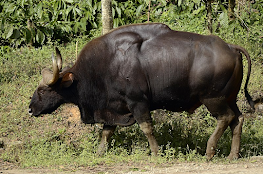Indian Gaur ( Indian Bison )
Relevance: Indian Gaur found dead in Nilgiris - The Hindu
Taxonomy:
Phylum: Chordata
Class: Mammalia
Order: Cetartiodactyla
Family: Bovidae
Sub-family: Bovinae
Genus: Bos
Species: Bos gaurus (H. Smith 1824)
Common name: Gaur
The Indian bison is a large sized animal belonging to a phylogenitically young group of mammals, the
Bovinae. There has been an inconsistency in the nomenclatural treatment of the wild and domestic
Gaur with several nomenclatural systems being proposed by different authors (Gentry et al. 2004). The
ruling by the International Commission on Zoological Nomenclature (2003), validating the usage of the
first available specific name for wild progenitor species has resolved this confusion. Accordingly, the
wild species of Gaur is recognized as Bos gaurus, while the domestic form (Mithun, Mithan or Gayal) is
referred to as Bos frontalis.
The genus Bos includes six extant species including B. gaurus (gaur), (Wilson and Reeder 2005),
confined to the Oriental Region (Schaller 1967). Many subspecies of gaur have been described;
however, the two currently recognized sub-species are Bos gaurus gaurus, occurring in India Nepal,
and Myanmar and Bos gaurus laosiensis (Heude 1901) from southern China, Lao PDR, Viet Nam,
Cambodia, Thailand north of the Isthmus of Kra and in West Malaysia (Srikosamatara and Suteethorn
1994). Recent work by Groves (2003) also supports this division.
Further, analysis of skull and horn measurements suggest that the Gaur in north-east India are likely to
be intermediate between the Indian and South-east Asian specimens but with more similarity to the
south-east Asian variety (cited in Duckworth et al. 2008). In consideration of these phenotypic
differences, B. g. gaurus and B. g. laosiensis have been provisionally accepted by IUCN as the two
sub-species of Gaur, pending further research required to determine the taxonomy of this species.
Geographical Distribution:
The historical distribution of
Gaur ranged throughout
mainland south and south-east
Asia and Sri Lanka. At present,
Gaur is distributed in South
and South-east Asia from India
to peninsular Malaysia,
occurring in India, Nepal,
Bhutan, Bangladesh,
Myanmar, Thailand, China,
Laos, Cambodia, Vietnam and
Peninsular Malaysia but extinct
in Sri Lanka (Grubb 2005). In
India, the distribution of Gaur
is highly fragmented and is confined to the Western Ghats, Central Indian highlands and the foot hills of
Himalayas, including the hills south of Brahmaputra River.
Threats and Conservation Actions:
The species is threatened by habitat loss, degradation and poaching (Choudhury, 2002; Areendran
2007; Duckworth et al. 2008); competition from domestic livestock (Pasha et al. 2004); disease
outbreaks in livestock (Salter 1983; Ranjitsinh 1997; Davidar 1997)
They are categorized as “Vulnerable” in the IUCN Red List of Threatened Species, 2009. It is protected
under Schedule I of the Wildlife Protection Act 1972 of India and is listed in Appendix I of the
Convention on International Trade in Endangered Species of Wild Fauna and Flora (CITES), which
bans all international trade of gaur products.
Conservation actions to ensure the long term survival of the species include livestock vaccination
programs, control of cattle grazing and ensuring protection (Ashokkumar et al. 2011). Additional efforts
include translocation to Bandahvagarh where the species went locally extinct in 1996 were undertaken
in 2011 and are summarised in Pabla et al. (2011) and Nigam et al. (2014).
- NATIONAL STUDBOOK, GAUR (Bos gaurus gaurus) II Edition, Central Zoo Authority
- Ecology of Gaur (Bos gaurus) in North Bengal, West Bengal Forest Department, Government of West Bengal
- H.S., Carlisle, L., Cooper, D., Cooke, J., Nigam, P., Sankar, K., Srivastav, A., Negi, H.S., Patil, C.K., Aggarwal, S., Mishra, A., Gupta, S., Srivastav, A.B., Chauhan, K.S. and Sarath, C. (2011). Reintroduction of Gaur (Bos gaurus gaurus) in Bandhavgarh Tiger Reserve, Madhya Pradesh, India. Technical report. 73 p.
- Gaur ( Wikipedia )


Comments